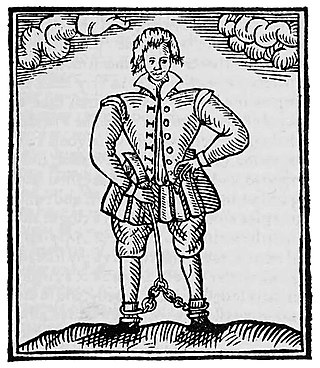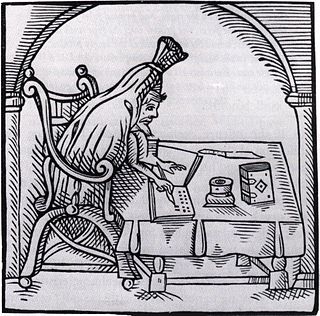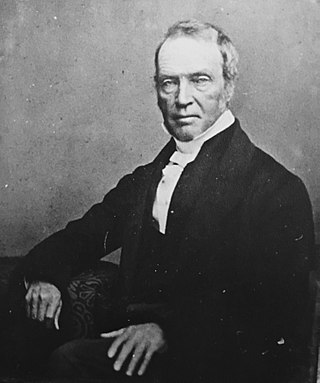
The Raigne of King Edward the Third, commonly shortened to Edward III, is an Elizabethan play printed anonymously in 1596, and at least partly written by William Shakespeare. It began to be included in publications of the complete works of Shakespeare only in the late 1990s. Scholars who have supported this attribution include Jonathan Bate, Edward Capell, Eliot Slater, Eric Sams, Giorgio Melchiori, and Brian Vickers. The play's co-author remains the subject of debate: suggestions have included Thomas Kyd, Christopher Marlowe, Michael Drayton, Thomas Nashe, and George Peele.
This article contains information about the literary events and publications of 1594.
This article contains information about the literary events and publications of 1592.

Thomas Nashe was an Elizabethan playwright, poet, satirist and a significant pamphleteer. He is known for his novel The Unfortunate Traveller, his pamphlets including Pierce Penniless, and his numerous defences of the Church of England.

Thomas Dekker was an English Elizabethan dramatist and pamphleteer, a versatile and prolific writer, whose career spanned several decades and brought him into contact with many of the period's most famous dramatists.

Martin Marprelate was the name used by the anonymous author or authors of the seven Marprelate tracts that circulated illegally in England in the years 1588 and 1589. Their principal focus was an attack on the episcopacy of the Anglican Church.

Gabriel Harvey was an English writer. Harvey was a notable scholar, whose reputation suffered from his quarrel with Thomas Nashe. Henry Morley, writing in the Fortnightly Review, has argued that Harvey's Latin works demonstrate that he was distinguished by qualities very different from the pedantry and conceit usually associated with his name.
The Ur-Hamlet is a play by an unknown author, thought to be either Thomas Kyd or William Shakespeare. No copy of the play, dated by scholars to the second half of 1587, survives today. The play was staged in London, more specifically at The Theatre in Shoreditch as recalled by Elizabethan author Thomas Lodge. It includes a character named Hamlet; the only other known character from the play is a ghost who, according to Thomas Lodge in his 1596 publication Wits Misery and the Worlds Madnesse, cries, "Hamlet, revenge!"

The Parnassus plays are three satiric comedies, or full-length academic dramas each divided into five acts. They date from between 1598 and 1602. They were performed in London by students for an audience of students as part of the Christmas festivities of St John's College at Cambridge University. It is not known who wrote them.

Dido, Queen of Carthage is a short play written by the English playwright Christopher Marlowe, with possible contributions by Thomas Nashe. It was probably written between 1587 and 1593, and was first published in 1594. The story focuses on the classical figure of Dido, the Queen of Carthage. It tells an intense dramatic tale of Dido and her fanatical love for Aeneas, Aeneas' betrayal of her and her eventual suicide on his departure for Italy. The playwrights relied on Books 1, 2, and 4 of Virgil's Aeneid as primary source.
The Isle of Dogs is a play by Thomas Nashe and Ben Jonson which was performed in 1597. It was immediately suppressed, and no copy of it is known to exist.
The Piers Plowman tradition is made up of about 14 different poetic and prose works from about the time of John Ball and the Peasants Revolt of 1381 through the reign of Elizabeth I and beyond. All the works feature one or more characters, typically Piers, from William Langland's poem Piers Plowman. Because the Plowman appears in the General Prologue to The Canterbury Tales by Geoffrey Chaucer but does not have his own tale, plowman tales are sometimes used as additions to The Canterbury Tales, or otherwise conflated or associated with Chaucer.

Robert Greene (1558–1592) was an English author popular in his day, and now best known for a posthumous pamphlet attributed to him, Greene's Groats-Worth of Witte, bought with a million of Repentance, widely believed to contain an attack on William Shakespeare. Robert Greene was a popular Elizabethan dramatist and pamphleteer known for his negative critiques of his colleagues. He is said to have been born in Norwich. He attended Cambridge where he received a BA in 1580, and an M.A. in 1583 before moving to London, where he arguably became the first professional author in England. Greene was prolific and published in many genres including romances, plays and autobiography.
Cuthbert Burby was a London bookseller and publisher of the Elizabethan and early Jacobean eras. He is known for publishing a series of significant volumes of English Renaissance drama, including works by William Shakespeare, Robert Greene, John Lyly, and Thomas Nashe.

The University Wits is a phrase used to name a group of late 16th-century English playwrights and pamphleteers who were educated at the universities and who became popular secular writers. Prominent members of this group were Christopher Marlowe, Robert Greene, and Thomas Nashe from Cambridge, and John Lyly, Thomas Lodge, and George Peele from Oxford. Thomas Kyd is also sometimes included in the group, though he was not from any of the aforementioned universities.

Richard Wilson Greene PC, KC (1791–1861) was an Irish barrister and judge.

Greenes, Groats-worth of Witte, bought with a million of Repentance (1592) is a tract published as the work of the Elizabethan author Robert Greene.

Pierce Penniless his Supplication to the Divell is a tall tale, or a prose satire, written by Thomas Nashe and published in London in 1592. It was among the most popular of the Elizabethan pamphlets. It was reprinted in 1593 and 1595, and in 1594 was translated into French. It is written from the point of view of Pierce, a man who has not met with good fortune, who now bitterly complains of the world's wickedness, and addresses his complaints to the devil. At times the identity of Pierce seems to conflate with Nashe's own. But Nashe also portrays Pierce as something of an arrogant and prodigal fool. The story is told in a style that is complex, witty, fulminating, extemporaneous, digressive, anecdotal, filled with wicked descriptions, and peppered with newly minted words and Latin phrases. The satire can be mocking and bitingly sharp, and at times Nashe’s style seems to relish its own obscurity.
Richard Harvey (1560-1630) was an English astrologer, theologian and controversialist.

A Knack to Know a Knave is a 1592 play closely associated with the principal performers Edward Alleyn and William Kempe. The play is a comic morality tale designed to highlight the talents of the celebrated clown Kempe, and is known from one text, itself arguably a memorial reconstruction. The author is unknown, though the involvement of Robert Greene has been suggested, as well as George Peele and Thomas Nashe. Recent scholarship has argued for a Shakespearean connection. On the basis of traditional literary-critical analysis and digital textual methods, Darren Freebury-Jones has proposed that the case for Robert Wilson's authorship of A Knack to Know a Knave is compelling. The play gives an insight into the nature of Elizabethan theatre during Shakespeare's time and the relationship between playscript and extemporised comedy.












